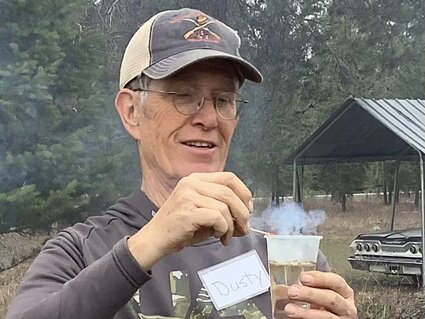Grange class teaches survival fire-making skills
April 4, 2024
Building a survival fire takes more than combustion, fuel and oxygen. It also takes a heavy dose of patience and preparation before the fire is even ready to be lit.
That was the primary message of the "How to Survive a Cold Night in the Mountains" class taught at Whitepine Grange recently by Dusty Rosenthal, a master outdoorsman from Yakima, Wash. Rosenthal had been asked to present a three-hour class that would cover the basics of how to avoid hypothermia when hikers, shed hunters and mountain adventurists find themselves stuck or lost in the woods and facing a cold night prior to rescue.
Rosenthal had eight participants in his class, with people coming from as far as Bonners Ferry and Perma. The class began indoors as he explained how hypothermia could be life-threatening but also easily avoided if outdoor enthusiasts brought some basic equipment along with them.
"Be prepared with the 'Five C's' of cold weather survival," he said. "Combustion, cover, cutting tools, container, and cordage." While combustion-starting fires-was on everyone's mind, he first explained the other C's. For cover, nothing beats a simple windproof raincoat. For cutting tools, he suggested a small saw and a good knife. A steel cup makes a perfect container, he said, for melting snow and boiling water. Cordage, like paracord or fiber wire can be used for building a shelter. Rosenthal added one more "C" from his personal list: calories. The calories in a simple energy bar can do wonders to warm a body that is otherwise fatigued and cold.
The main attraction of his class was the fire-building segment, which began with each student assembling a fire-starting kit from materials he provided: waxed cotton balls, Bic lighters, fatwood, and Ferro stick with striker, all of which fit in a quart-size zip-lock bag. Before moving outdoors, the students practiced making sparks with their Ferro sticks. Rosenthal explained that there were easier ways to start survival fires (like Bic lighters and waterproof matches) but the Ferro stick was always a good backup if another ignition source failed to work.

The class moved outdoors where they were directed to find sufficient tinder in the forest to start a fire. This was the task requiring patience, time and work, especially since conditions were wet and chilly. "Moisture is the biggest enemy of fire," he warned, while showing them how to find and test the most appropriate tinder. "If it's on the ground, don't even pick it up because it will be too wet. Look for tiny little branches at the base of fir trees and close to the trunk."
Rosenthal instructed the class on how to build a "stack" fire by first laying a foundation of wood branches to keep the burning materials off the cold, damp ground. The students then placed their waxed cotton balls atop the foundation, ignited them with Bic lighters, and immediately placed thick bundles of tinder over the flaming cotton balls. This produced an intense, torch-like flame. Next, slightly larger twigs were added by bundles-not one stick at a time-and eventually the bigger branches were added to sustain a substantial fire long enough to allow the fire-starters to walk away and find more wood. Sustaining a fire for seven or eight hours, he said, takes a tremendous amount of effort. The key is to get a good, hot fire going as soon as possible and then keep it going.
Mackenzie Harrison, Plains, was one of the participants. As an enthusiastic hiker and camper, she remarked, "This class was great in filling my knowledge gaps about building a fire and preventing hypothermia while outdoors. I now feel confident that I could build a fire even in bad weather if I needed to."
"This class drives home the need for self-sufficiency," said Bob Rains of Bonners Ferry, Idaho. "Knowing how to build a survival fire out of minimal materials is a basic skill that could help any one of us survive another day."
Rosenthal, a Yakima resident for more than 60 years, has spent countless nights in the Cascade Mountains of Washington, where he enjoys hunting, hiking, and exploring. "I always pack minimally and yet I can be quite comfortable for several days, knowing how to utilize what I have with me."



Reader Comments(0)